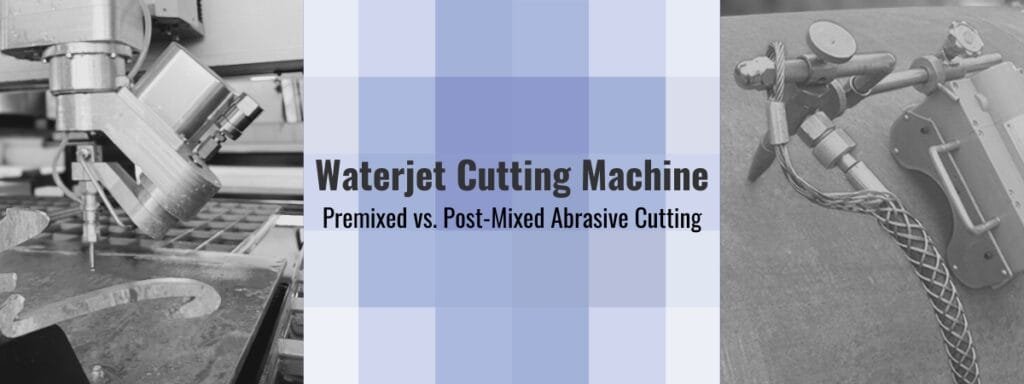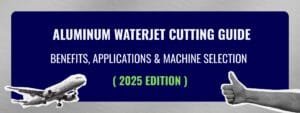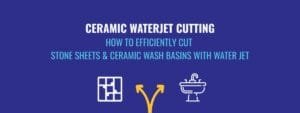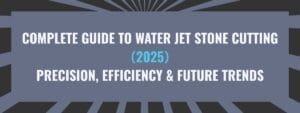Learn about the two core waterjet cutting machine technologies – premixed abrasive cutting and post-mixed abrasive cutting. This article covers their differences, pressure ranges, nozzle features, industry applications, and future trends across energy, oil, mining, chemical, military, and engineering sectors.

What is a Waterjet Cutting Machine?
A waterjet cutting machine uses high-pressure water, with or without abrasive particles, to cut materials with precision. Its main advantage is cold cutting, which generates no heat or thermal deformation, making it ideal for both industrial manufacturing and specialized field operations.
In abrasive waterjet technology, there are two main methods: premixed abrasive cutting and post-mixed abrasive cutting. They differ significantly in pressure range, nozzle flow, precision, and application scenarios.
Premixed Abrasive Cutting
Technical Features
- Operating Pressure: ≤200 MPa
- Nozzle Size: Large, high water flow
- Cutting Precision: Low, not suitable for fine machining
- Equipment Form: Handheld or portable
Advantages
- Cold cutting, safe for flammable or explosive environments
- Portable and flexible, can be used in tight or hazardous spaces
- Effective for demolition and rough cutting, where precision is not critical
Applications
- Energy & Oil: Tank maintenance, pipe cutting
- Mining: Emergency and underground coal mine operations
- Chemical Industry: Pipe maintenance, equipment dismantling
- Military: Landmine disposal, obsolete munition demolition
- Construction & Maintenance: On-site repairs, emergency operations
- Demolition & Reconstruction: Safe cutting of concrete or steel structures
Post-Mixed Abrasive Cutting
Technical Features
- Operating Pressure: ≥280 MPa (commonly 300–420 MPa in industrial systems)
- Nozzle Size: Small, typically 0.33 mm, ensuring cutting precision
- Cutting Precision: High, suitable for intricate shapes and details
- Equipment Form: Machine-tool style cutting tables, factory use
Advantages
- High precision and clean edges, minimizing the need for secondary finishing
- Lower nozzle wear, prolonging service life
- Efficient energy use, ideal for complex shapes and mass production
Applications
- Manufacturing: Aerospace components, automotive parts, glass, ceramics, stone
- Engineering: Tunnel excavation, shield machine operations
- Infrastructure: Concrete pile maintenance, road and bridge repair
- Offshore: Oil rig and marine platform maintenance
- Large-scale Demolition: Cutting reinforced concrete structures
Comparison: Premixed vs. Post-Mixed Abrasive Cutting
| Aspect | Premixed Abrasive Cutting | Post-Mixed Abrasive Cutting |
| Pressure Range | ≤200 MPa | ≥280 MPa |
| Nozzle Size / Flow | Large, high flow | Small, precise flow (0.33 mm) |
| Cutting Precision | Low, rough cutting | High, precision cutting |
| Equipment Form | Handheld / portable | Machine-tool style |
| Application Environment | Hazardous sites, emergency operations | Factory production, engineering projects |
Wide Applications of Abrasive Waterjet Technology
Abrasive waterjet cutting machines are not limited to factory machining. Depending on the technology used, both premixed and post-mixed systems serve important roles across diverse industries and field operations.
Premixed Applications
With medium to low pressure (≤200 MPa) and high water flow, premixed systems excel in portable, on-site, and hazardous operations:
- Energy & oil: Tank maintenance and pipe cutting
- Mining: Underground coal mine rescue and emergency operations
- Chemical: Pipe maintenance, equipment dismantling
- Military: Landmine disposal, obsolete munition demolition
- Construction & maintenance: Municipal repairs, emergency site operations
- Demolition & reconstruction: Concrete and steel structure cutting
Post-Mixed Applications
High-pressure post-mixed systems (≥280 MPa, 0.33 mm nozzle) are extending beyond factory precision machining into engineering and infrastructure:
- Tunnel construction: Cutting rock and concrete with shield machines
- Road and bridge maintenance: Concrete pile repair and surface cutting
- Offshore engineering: Oil rigs and marine platform maintenance
- Large-scale demolition: Reinforced concrete and steel structures
Both premixed and post-mixed abrasive waterjet cutting technologies have become essential tools in modern industry:
- Premixed systems offer safety, portability, and cold cutting, making them ideal for high-risk environments and emergency operations.
- Post-mixed systems deliver high pressure, high precision, and efficiency, suitable for factory manufacturing and increasingly applied in engineering projects.
With the growing adoption of waterjet cutting technology, waterjet cutting machines are becoming a critical tool bridging manufacturing and engineering applications, providing safe, efficient, and precise cutting solutions across multiple industries.



